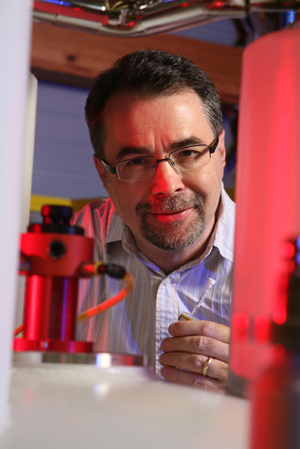Grants helping scientist tell complex tale of proteins and metabolites

A Florida State University biophysical chemist has received two large grants totaling more than $1.66 million to pursue research into the behavior of proteins, particularly their dynamics, and their interactions with one another and with other complex molecules found in living organisms. His research, while at a fundamental level, has the potential to serve as a building block for future inroads in the diagnosis and treatments of a variety of diseases.
Rafael Brüschweiler, a professor in Florida State's Department of Chemistry and Biochemistry and associate director for biophysics at the National High Magnetic Field Laboratory, recently received a four-year research grant from the National Institutes of Health (NIH) in the amount of $1,055,476. Shortly afterward, he received a second four-year grant, that one valued at $608,782, from the National Science Foundation (NSF).
Over the past several years, Brüschweiler has been an innovator in the use of nuclear magnetic resonance (NMR) technology for protein research. NMR is a research tool that utilizes high-powered magnets to measure the strengths, directions and temporary fluctuations of magnetic interactions at the location of essentially each atom in a protein.
"Proteins are highly complex molecules that perform a wide range of biological functions in every organism," Brüschweiler said. "Proper function requires the fine interplay between a protein's structure and its dynamics. In our work, we show how such protein behavior can be observed at the atomic level by the combined use of NMR experiments and sophisticated computational tools. These findings are essential for our understanding of protein function."
Working with Brüschweiler on both research projects is his colleague and wife, Lei Bruschweiler-Li, an assistant scholar/scientist in the Department of Chemistry and Biochemistry, as well as other scholar/scientists at the magnet lab and a number of graduate students and postdoctoral researchers.
For the NIH project, Professor Brüschweiler will use a precise analytical technique developed in his laboratory, known as covariance NMR, to produce high-resolution spectra of both proteins and of small biomolecules known as metabolites, which play a critical role in essentially all biological processes that happen in an organism.
"A major part of this work focuses on the development of methods for the rapid analysis of complex biological mixtures," Brüschweiler said. "The comprehensive analysis of the metabolites of a cell or a whole organism is known as metabolomics. Metabolomics helps in biomarker identification for diagnosis of diseases and will lead the way to personalized medicine. Some of the research tools we develop are being made available via public Web servers to allow scientists across the world to analyze their own experimental data with our algorithms."
While the NSF project also involves biomolecules, it has a somewhat different focus: Brüschweiler's work aims to understand the relationship between protein structure and dynamics and to document the interactions of proteins with each other and with smaller molecules.
"It is a dynamic protein world out there, and we're seeking to answer some fundamental questions," he said. "How do proteins precisely behave and perform their function at an atomic level? We know that these molecular machines behave in an orchestrated manner, but how exactly? Using NMR, we can observe proteins under conditions that are similar to the ones encountered in a living cell. This gives us a very good sense of how and why they do what they do."
Even powerful NMR analysis won't provide all of the information Brüschweiler is looking for, however. To further hone his observations, he will take the NMR data collected at the magnet lab and combine them with detailed computer simulations to draw an even more vivid picture of the proteins' behavior.
"We'll make use of NMR experiments and the university's very powerful High Performance Computing Center to do these extensive simulations," he said. "NMR analysis and high-performance computer simulations are synergistic methods that enable us to greatly enhance our insight the complex behavior of proteins."
To view an abstract for Brüschweiler's NIH, proposal, titled "Covariance-Based NMR of Proteins and Complex Metabolite Mixtures," visit this link and type "Bruschweiler" into the box labeled "Principal Investigator (last name)." To view an abstract of the NSF proposal, "Dynamics and Thermodynamics of Proteins by NMR and Computation," visit this link.
"It is a dynamic protein world out there, and we're seeking to answer some fundamental questions."
Rafael Brüschweiler
Florida State University Department of Chemistry and Biochemistry
